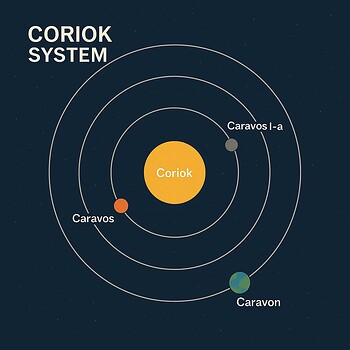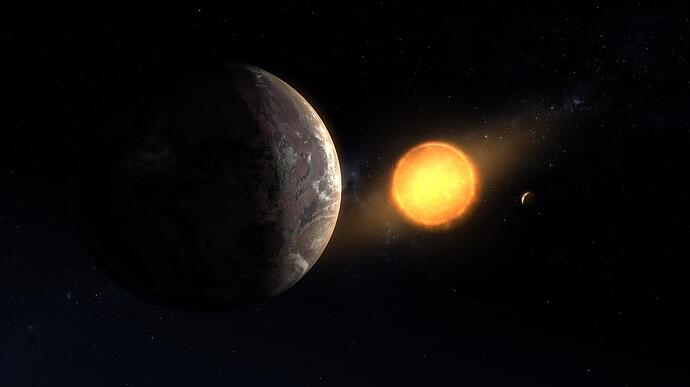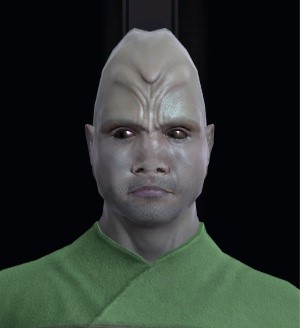Astrometrics Database: Coriok System & Inhabiting Species
| Coriok System |
| Sector: Betazed Sector, Alpha Quadrant |
| Primary Star: Coriok (G-type main sequence) |
|
Planets: • Coriok I – "Caravos" (Class M) • Coriok II – "Caravon" (Class M) |
| Major Moon: Coriok I-a – "Helkin"(Class D, barren) |
| Inhabitants: Coriokian (Caravosians / Caravonians) |
| Population: ~800 million (Caravos), ~102 million (Caravon) |
| Capital: Heleris (Coriok I / Caravos) |
| Government: Dual planetary councils, Federation member representation |
| Affiliation: United Federation of Planets (since 2311) |
| Economy: Dilithium mining, subterranean agriculture, light-filtering textiles |
| Strategic Value: Logistical waypoint; bunker networks of Dominion War era |
![]()
Overview
The Coriok system lies close to Betazed in the Betazed Sector. Two inhabited worlds orbit the star of Coriok, a yellow main sequence sun. Though modest in population, the system has been strategically significant since the Dominion War, when deep bunker networks on Coriok II (Caravon) supported defensive operations and supply caching. Today, it maintains industrial output with dilithium extraction, while Coriok I (Caravos) remains the cultural and political heart for the inhabiting species.
Astrometric surveys show that Coriok’s stellar emissions run slightly hotter and more ultraviolet-rich than Sol, a factor which shaped the evolution of local biology. This spectral bias explains the native species’ notable light sensitivity and their architectural emphasis on filtered illumination. Seasonal flares, while rarely catastrophic, contribute to the common practice of subterranean refuge-building that is still culturally significant long after advanced shielding made it unnecessary.
From a navigational perspective, Coriok is regarded as a quiet crossroads in Federation cartography. Trade routes from Betazed and Risa often converge here before fanning out toward lesser-charted frontier sectors. Though not a major hub, its starports see a steady trickle of freighters, science craft, and Starfleet patrols. The system’s understated role as a logistical waypoint belies its importance in maintaining cohesion along the Federation’s Alpha and Beta Quadrant transition. The dilithium mineral deposits on Coriok II are also in end stage depletion, with the majority of Federation-level extraction operations now discontinued.
Starfleet Field Notes
- Local Inhabitants
- Known collectively in Federation records as the Coriok, though they self-identify as Caravosians (of Caravos) and Caravonians (of Caravon). Humanoid, with marked light sensitivity due to their sun’s spectrum. Culturally peaceful, consensus-driven, and more invested in subterranean life and local stability than deep-space expansion.
- Technology Level
- Native warp development, robust civil engineering. Photobiology and materials science emphasise glare mitigation and spectral filtering.
- First Contact
- Pre-Federation exchanges with Betazoids; gradual integration into UFP frameworks thereafter, with full membership achieved in 2311.
- Attitude to Starfleet
- Positive, with preference for local autonomy. Starfleet assistance welcomed in off-world threats or spaceborne hazards, but internal affairs are managed independently.
- Operational Note
- Carry Category-III ocular accommodation kits for any embarked Caravosian personnel. Avoid high-intensity strobes in shared spaces to prevent disorientation.
Stellar & Planetary Data
Image shows Coriok I - 'Caravos' framed by system star, with orbiting moon Coriok I-a - 'Helkin' in view
![]()
- Primary Star — Coriok
- Class: G-type main sequence
- Notes: Slightly higher ultraviolet output than Sol, with periodic stellar flares influencing local biology and cultural adaptation.
- Coriok I — 'Caravos'
- Class: M
- Population: ~800 million
- Notes: Primary homeworld of the species. Temperate hydrosphere, varied biomes, and extensive light-filtering architecture. Subterranean arcologies integrate with surface greenscapes to manage solar exposure.
- Coriok I-a — 'Helkin'
- Class: D
- Population: Nil
- Notes: A barren rocky moon with high surface reflectivity. Uninhabited, but used as a relay station and training site for orbital operations. Prominent in Caravos’ night sky and regarded in folklore as “Helkin, God of Chance”.
- Coriok II — 'Caravon'
- Class: M
- Population: ~102 million
- Notes: Later colony, sparsely populated, industry-oriented. Proven dilithium deposits (now nearing depletion), with heavy mining infrastructure and interlinked bunker complexes dating to the Dominion War era.
| Species Profile |
| Endonym: Caravosian, Caravonian |
| Exonym: Coriok (Federation usage) |
| Physiology: Humanoid, high light sensitivity |
| Lifespan: ~90 years (by Sol reckoning) |
| Languages: Caravosian, Federation Standard |
| Homeworld: Caravos |
| Affiliation: United Federation of Planets |
![]()
The Coriok Races
It is commonplace to see the use of ‘Coriok’ or ‘Coriokian’ in reference to the species which inhabits the Coriok system in records across the quadrant, when the species themselves prefer the terms Caravosian for those of the primary world (Caravos) and Caravonian for colonists of the system’s second planet (Coravon). In this regard, one might consider the species as two races, though there is insufficient genetic variation to support this. Rather, it could be reflected as being a more ‘cultural’ categorisation.
Indeed, this difference in exonymic over endoynmic terminology is an ongoing cause of confusion, even at Federation council meetings. In their language, Caravos means “of home”, and Caravon means “of little/smaller home”, and Caravosian or Caravonian alike, feel these terms are more apt in describing their species colloquially.
Caravosians evolved under a bright stellar spectrum and possess light-sensitive eyes. Cities commonly incorporate filtered skylights, adjustable canopies, and below-ground concourses to soften glare and light in general. Visitors will notice cool blue-green interiors and public thoroughfares that move seamlessly between surface and sub-surface levels.
Although warp capable by native development, the species has historically preferred local stability over long-range expansion. Their off-world presence remains focused within the Coriok system, with limited exploratory cruisers and research craft operating beyond.
Docile Nature
The Coriok races are unusually docile in nature, a trait that has been consistently recorded since first contact. Their culture is built upon a foundation of peace and consensus-driven decision-making, favoring assemblies to settle disputes rather than resorting to violence or warfare. This non-aggressive stance extends to their interstellar relations, as demonstrated by their peaceful integration into the United Federation of Planets and their cooperative yet non-combative role during galactic conflicts. Their documented history reveals a pragmatic and serene people who consistently prioritize internal harmony and the continuation of their culture above all else.Culture and Notable Traits
- Management of Light
- Notes: Ubiquitous use of visors or ocular veils off-world. Architecture favours indirect daylight, reflective baffles, and tinted glazing.
- Subterranean Arcology
- Notes: Interlinked civic spaces below ground reduce glare and thermal load, while maintaining ventilation and plant-light spectra tuned for crops.
- Cuisine
- Notes: Root vegetables, fungal grains, and aquaculture staples. Popular beverages infuse mineral water with bioluminescent algae, giving a soft turquoise glow at table.
- Craft & Design
- Notes: Polished stone composites, pale metals, and textile blinds with iridescent threads that double as personal sun-filters.
- Proverb
- Notes: “One light, two homes.” A reminder of unity across Caravos and Caravon.
![]()
The Abridged Historical Record
Early History
Long before Betazoid influence extended into the region, the Caravosians maintained a quiet agrarian civilisation, their societies shaped by the rhythms of subterranean agriculture and the need to adapt to their sun’s intense light. Early records describe them as pragmatic engineers of light and stone, building their first true cities underground while their surface settlements remained small and transient. Conflict was rare; most disputes were settled through consensus assemblies rather than warfare.
Increasing Influences
Betazoid traders and scholars began visiting the system centuries before formal contact. Cultural exchanges were gentle but enduring: Caravosian craftworkers adopted Betazoid artistry in glass and metal, while Betazoid households prized the fine mineralware of Caravos. There are even records that the celebrated Chalices of Rixx once travelled through Coriok on ceremonial tours, their presence considered a mark of mutual esteem. To this day, reproductions of the chalices are displayed in civic halls on Caravos as symbols of friendship and refinement.
For a long era, Coriok lay within Betazoid political orbit, though never under coercion. The Caravosian governing council enjoyed a degree of autonomy, while Betazoid advisors and merchants helped steer external relations. When Betazed began negotiations to join the Federation in 2270s, one of its conditions was the recognition of Coriok’s peaceful independence, ensuring their neighbours would be free to decide their own destiny rather than be treated as a dependency.
More 'Recent' Events
The later colonisation of Coriok II, known as Caravon, was encouraged by Betazoid allies in the early 24th century. While conceived partly as an industrial extension of Caravos’ economy, it also had a defensive purpose: to create a hardened world with resources and shelters that could serve as a fallback in times of crisis. During the Dominion War, Caravon’s deep bunker networks and mining galleries proved invaluable as protected supply depots and emergency sanctuaries. Yet even here, the Caravonians maintained the same defensive pragmatism as their kin, resisting violence unless provoked, and focusing on survival rather than conquest.
This arrangement bore fruit in 2311, when Coriok’s governing councils (on Caravos and Caravon) chose to jointly and formally accede to the United Federation of Planets. The worlds were welcomed as peaceful partners, notable for their internal harmony and reluctance to arms. Even during the war years that followed, their policies emphasised endurance, cultural continuity, and shared identity across both worlds. Today, they remain respected for their stability, pragmatism, and steady voice within the Federation council.
![]()
Notable Events
- Pre-2273
- Reproductions of the Chalices of Rixx displayed in Caravos civic halls, reflecting long-standing cultural exchange with Betazed following tour of the originals.
- 2300
- Colonisation of Coriok II ("Caravon") begins; conceived as both an industrial expansion and a safeguard settlement, encouraged by Betazoid advisors.
- 2311
- Caravosian governing council vote to accede to the United Federation of Planets, formalising membership with nomination by their Betazoid neighbours.
- 2373–2375
- During the Dominion War, Caravon’s bunker networks are designated as emergency supply depots. Starfleet Engineering Corps assists in reinforcing key sites.
- 2409
- Starfleet patrol routes officially log Coriok as an Alpha Quadrant crossroads for supply convoys to the Beta Quadrant. Minor skirmishes with Orion raiders prompt this, and the classification helps to ensure a continued patrol presence.
- 2414
- During the Iconian War, Caravos’ proximity to Betazed places the system on heightened alert. Starfleet auxiliary depots in Caravon’s bunkers are reactivated, and relief convoys bound for Betazed make staging transits through the system.
- 2417
- Amid escalating conflict with the Tzenkethi, Coriok is designated a logistics waypoint for defensive patrols. Caravosian and Caravonian authorities issue joint declarations of solidarity, emphasising their peaceful stance while cooperating with Starfleet to safeguard shipping lanes.
- 2420
- Federation Science Council establishes a spectral observatory on Caravos’ surface to study Coriok’s ultraviolet flares and their impact on local biology.
Databank Image Sources
- Solar System schematic produced using photoshop
- Picture of planet and star is actually a NASA illustration of Kepler-1649c at ACD20-0044-001 - NASA Science
- Species image is own alien creation in STO


